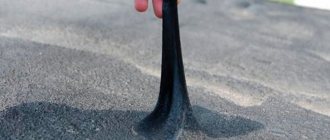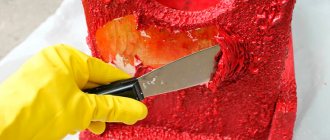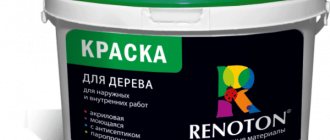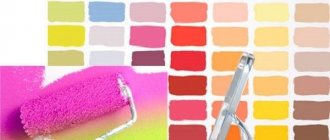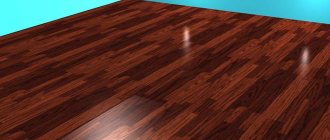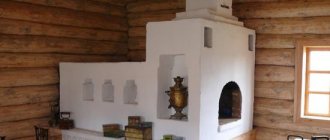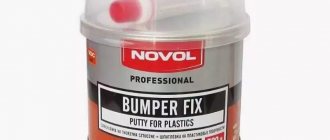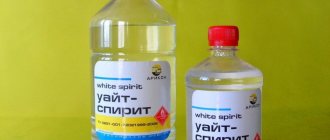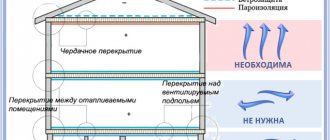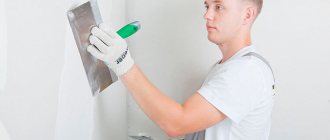Updated: 03/06/2021 12:58:10
Expert: Konstantin Borisovich Polyakov
*Review of the best according to the editors of expertology.ru. About the selection criteria. This material is subjective in nature, does not constitute advertising and does not serve as a purchase guide. Before purchasing, consultation with a specialist is required.
Concrete walls and ceilings are found in many houses and apartments. This durable base can withstand high loads, but has a porous structure. Concrete absorbs large amounts of moisture, which is why the outer layer of the coating often peels off. Therefore, manufacturers of paints and varnishes have created a special series of compositions for painting concrete bases. Today there is a wide selection of concrete paints on the Russian market, so when purchasing, certain difficulties may arise. With the help of our experts, we will try to highlight several of the most important selection criteria.
How to choose concrete paint for facades?
Paint requirements
The use of correctly selected facade dyes for treating concrete surfaces not only improves the appearance of structures, but also significantly extends their service life. That is why specialists have a number of requirements for coating concrete surfaces:
- increased strength;
- resistance to mechanical stress;
- anti-corrosion qualities;
- wind resistance;
- frost resistance;
- UV resistance.
What should you consider when choosing paint?
The most important property of facade paints for concrete is moisture resistance, since the coating will be regularly exposed to moisture.
In addition, the composition must be resistant to fire, which means it must not contain flammable substances.
No less significant properties of such coatings are:
- good adhesive ability - if façade paint on concrete does not adhere well to the base, then peelings cannot be avoided in the future;
- UV resistance - in this case the coating will not fade under direct sunlight;
- ability to withstand temperature fluctuations – the coating must easily tolerate temperature changes from -40 to +40 degrees;
- ability to pass steam - otherwise condensation will accumulate on the surface;
- resistance to stains - the paint must contain antibacterial components that will prevent the formation of mold and mildew.
Consumption per 1m2
Consumption standards for façade paints for concrete depend on the type of dye:
- acrylic compositions: 130-200 g/m2;
- alkyd compositions: 100 g/m2;
- oil compositions: 150 g/m2;
- silicate compositions: 100-400 g/m2;
- rubber compounds: 100-300 g/m2;
- water-based compositions: 110-130 g/m2.
Features of concrete surface
Concrete is one of the materials in construction with a long history. Previously, it was based only on sand and lime, but now cement is added to them. The main qualities include a structure with increased roughness. A lot of moisture collects on the surface layer, products absorb it in large quantities. Increased adhesion to substrates will be provided by façade paint on concrete.
The main qualities include a structure with increased roughness.
Technology for painting a concrete facade: instructions and video
Is it possible to paint aerated concrete without plaster?
The classic algorithm for preparing a concrete surface for subsequent painting is not always appropriate, especially if painting the walls is only a temporary measure to create the final appearance of the house.
If plastering of the walls is not planned, it is necessary to understand that the porosity of the facade contributes to a high absorption of moisture, which means the dye consumption can increase by five times.
In this case, a mandatory preparation step will be priming the surface with several layers of deep penetration soil solution. Two or three layers of primer will reduce the absorbency of the material, which will significantly reduce dye costs.
After priming, any suitable material for facade work can be applied to the surface. The main thing is to pay attention to the dye consumption and take at least twice as much material.
How to prepare the surface
Before applying the composition, it is necessary to carefully prepare the surface:
- clean the walls from dirt and dust;
- eliminate existing defects using plaster;
- prime the walls (to improve the adhesion of the coating to the concrete).
The end result should be as flat and smooth a surface as possible.
The process of preparing concrete walls for painting is described in detail in the following video:
How to apply paint correctly
You can apply the paint in any convenient way - with a brush, roller or spray.
Experts strongly recommend using a roller to apply the first layer, and using a spray bottle exclusively for the second and subsequent layers - in this case, it will be possible to achieve the most even coating. It is recommended to use a brush to apply dye to hard-to-reach places.
How to Paint Concrete Walls, Foundations and Fences
To properly paint a concrete wall or concrete fence, the surface must be carefully prepared, regardless of which paint is chosen:
- Remove remnants of previous paint, dirt, mold, fungi;
- Fill all defects (cracks, irregularities, chips, holes) with primer to prevent moisture accumulation. Achieve a smooth surface;
- Do not carry out work in rainy weather;
- Prepare in advance the necessary materials and tools: buckets, brushes, rollers, gloves, ladders, stepladders, scaffolding;
- To estimate the required amount of paint, you need to multiply the area (in square meters) by the consumption indicated on the packaging. The result obtained must be at least doubled, since several layers are often required.
After the preparatory work is completed, the painting stage begins. First you need to decide which foundation paint is best for you, based on your budget. Since the foundation is in the ground, gray paint can be used to save money. It is better to start from the top point of the wall, moving gradually down. Application should be carried out at a speed that ensures uniform distribution of paintwork materials over the surface. Before applying the next layer, you should wait until the first one has dried.
The choice of paint for a concrete fence can be approached for reasons of minimizing costs: on the façade, prestigious side, it is worth applying more expensive paint with a long service life, for example, acrylic, and on the reverse side, choose a cheaper option - lime.
It is known from practice that a coating formed by a set of thin layers has greater hardness than one thick film of paint.
Where to buy concrete paint for exterior use?
In Moscow
In Moscow, you can purchase façade paints for concrete from the following organizations:
- “Master Tibot”: official website: https://mastertibot.ru;
- address: Moscow, Kyiv highway, 2nd kilometer;
- telephone.
- official website: https://www.mirkrasok.ru;
- official website: https://1001kraska.ru;
In St. Petersburg
In St. Petersburg, the following companies sell facade paints for concrete surfaces:
- “Vlagoshchit”: official website: https://vlagoshchit.rf;
- address: St. Petersburg, Yakhtennaya street, building 3, building 2;
- telephone.
- "Olvia": official website: https://olvia-color.ru;
- address: St. Petersburg, Glukhoozerskoe highway, building 11;
- telephone.
- official website: https://petrovich.ru
Thus, the modern construction market allows you to choose facade paint for concrete to suit every taste and color. Therefore, if you can’t choose a color yourself, you should trust a specialist. The work experience and professional skills of a sales consultant or an experienced craftsman will allow you to select a dye in strict accordance with the requirements and wishes of the customer, as well as taking into account all the features of a particular facade.
Did this article help you? We would be grateful for your rating:
How to dilute
To choose the right solvent, you need to consider the type of paint itself and the substances that it contains. Some formulations allow ordinary water, others require additional substances to provide the desired effect. All important information is often indicated in the instructions. This also applies to how to get a good color.
To choose the right solvent, you need to consider the type of paint itself and the substances that it contains.
Additional Information
Drying time and consumption are characteristics, the determination of which helps to optimize the time spent on work. Manufacturers usually write on the label how long it takes for the layer to dry completely. After this, they usually proceed immediately to the next coating. Concrete paint dries on average within 2-5 hours. But the concrete becomes completely ready in at least a day.
120-400 ml of the composition is required to cover a square meter of surface with one full layer of paint. Specific characteristics depend on the type of paint used.
Painting concrete outside involves a preparatory stage - cleaning the working surface. There should be no grease and oil stains on the concrete, as well as dirt, dust, and lime. The old paintwork is also completely removed, otherwise weather-resistant coatings will not be created.
When it comes to external facades, a strong stream of ordinary water can be used to wash away dirt. In other cases, the impact should be more severe.
A grinder and a drill, a brush and metal brushes also become indispensable assistants when cleaning the surface. For brushes, it is important to use the shortest possible bristles. Paint chips will clog the lint if the work surface gets too hot.
How else can you paint concrete (2 videos)
Products of different brands (24 photos)
Methods for protecting unheated concrete structures
You can prevent the wear of the floor and give it an aesthetic appearance by painting. Compositions of paints and varnishes have been developed that are resistant to weather conditions and have good adhesion to concrete. However, some release toxins when dry and can only be used for outdoor use.
Others use it indoors, but the protective film is destroyed in the cold. Still others penetrate deeply into the top layer of the coating. The fourth, in the form of a water-soluble powder, is added to the batch, coloring the dough and forming bricks from it for paving stones.
In each case, a special painting technology, tools and dyes are used. The master must know where a specific paint composition can be applied, application methods, and drying time. Employees of a specialized organization will help you understand the features of paints and perform surface protection in a technologically correct manner using professional tools. The protection they provide will last a long time.
Tips and recommendations for use
In order for the material to perform its functions as efficiently as possible, it is necessary to take into account the rules of application.
Top tips:
- Preparation for painting, including cleaning of oils and dust and surface finishing. In addition, it is necessary to take care of the complete cleaning of the walls and screed on the floor;
- Priming the walls before painting;
- You can paint with a roller or brush. The best option is a spray bottle. Thanks to it, time is saved and maximum effect is achieved;
At the end, after all the work has been completed, you can apply a varnish coating, which is used to paint concrete and protect surfaces.
Important. If you do not follow the tips and recommendations, after a short amount of time the paint will begin to peel off and self-destruct. Compliance with all stages guarantees a long-term guarantee and quality.
Preparing for painting
In order for the work of painting a concrete facade to achieve the expected result, the surface should be prepared before starting it.
- Leveling - cracks, seams, crevices, protrusions and other irregularities must be repaired and leveled.
- Cleaning - the concrete surface must be cleaned of dirt, dust, oil stains and any other contaminants.
It would be a good idea to rinse the surface with water using a mini car wash. Strong water pressure will not only wash away all the dirt, but also reveal weak points. It is better to wash and repair crumbling areas of the wall before painting, rather than having them fall off with the paint later.
If you need to repair damaged areas with fresh solution, you should wait until it dries completely. Then coat the facade with a primer composition corresponding to the type of paint chosen.
Interior work on concrete floor
Artificial stone is a mass frozen into a monolith, adjacent to natural inert materials, efflorescence crystals, voids and small air bubbles. If you do not protect the monolith, structural changes will begin in it due to the ingress of water, spilled liquids, and dirt.
Application of paints and varnishes to a concrete floor will provide:
- A barrier to the penetration of water and chemically active substances into the mass.
- There is no dusting due to abrasion of the concrete layer and erosion.
- Use of reduced strength grades in construction, saving on material with optimal durability.
- Easy to maintain aesthetically pleasing coating.
When choosing a method of protecting a concrete floor using paints and varnishes, it is necessary to select the type of coating that corresponds to the operating conditions.
Compositions recommended for protecting concrete floors indoors
The development of polymer chemistry has created the opportunity to create various compositions of film-forming compounds. We advise you to pay attention to domestic manufacturers. The quality of their products is not inferior to foreign analogues, and the prices are lower. We suggest considering protective equipment, “TeoKhim”, “KrasKo”.
| Index | Mizar Akromat 200 | KrasKo Aquapol | KrasKo Texipol |
| The basis | Organic | Acrylates | Acrylic resin |
| Type | One-component | Water-based, one-component | Org. sol. one-component |
| Drying | 1 hour | 1 hour | 1 hour |
| Load | In a day | In 12 hours | In 24 hours |
| Temperature | -10 +40 0 С | From +5 0 C | -5 +30 0 С |
| Consumption g/m2 | 180-250 | 300-400 | 75-150 |
| Price RUR/kg | 275 | 190 |
Manufacturers also offer other composites designed to protect particularly loaded areas for general technical purposes. Thus, “Polybetol” can withstand temperatures from -60 to +100 and creates a protective barrier that is inert to chemicals and can withstand heavy mechanical loads.
The two-component composite “Elakor-PU EmalLux” from the TeoKhim company is a durable coating that provides chemical protection, working in open sunny areas and indoors. The composition is also used for pouring when creating a polymer floor. Cost 550 rub./kg.
We invite the buyer to study the recommendations for the use of the two-component product “AKROPUR B50” from the Mizar company. The protective properties of the material are so high that they allow it to be used in warehouses with aggressive liquids. The composite has a high hiding power, only 100-120 g/m2, which is significantly lower than imported analogues. The price of the product is only 282 rubles per kilogram.
Examples of effective protective coatings are given; there are many more of them in the catalogues. You can find the right product with the help of specialists.
Paint selection
Paints and varnishes include liquids that, when applied in a thin layer, create a protective film on the surface. All paints contain a coloring pigment in the form of a suspension, which, when dried, forms a durable elastic film. The properties of the coloring product depend on the type of solvent - varnish, oil or water. The esters released during drying have varying degrees of harmfulness. This is the defining characteristic for the place of application - interior or exterior paint.
There are aqueous suspensions:
- Acrylics are harmless polymer-polyacrylates and pigments dissolved in water. Can be used indoors and outdoors, the film is stable, the paints do not fade in the sun, applied with a roller or brush in 2 layers.
- Vinyl is a universal, quick-drying, odorless suspension that dries in 2-3 hours. The coating is abrasion-resistant, hypoallergenic, service life is 7 years. Disadvantage: low moisture resistance. Vinyl with organic solvents is a moisture-resistant coating for outdoor use.
- Rubber (latex) - water-dispersed with the addition of acrylates, dry within 20 minutes, a persistent elastic film is formed even when applied at subzero temperatures. The coating is soft to the touch. It is not afraid of moisture and serves to protect the blind area and the pool.
- Silicone emulsions based on polyorganic resins and acrylates do not accept dirt and mold, are resistant in a humid environment, the film masks cracks, durability is up to 25 years. The film is not destroyed by ultraviolet radiation and temperature changes. Divided into brands for external and internal use.
- Acrylic-silicone is used only for facade work, elastic, heat-resistant, and reasonable in terms of price and quality.
However, paints and enamels made with organic solvents form a more durable film that is resistant to sudden temperature changes. They are not afraid of precipitation or ultraviolet radiation. When drying, such paints and varnishes emit toxic compounds into the atmosphere, and their use indoors is prohibited or limited.
Paintwork materials based on organic solvents:
- Polyurethane one-component and two-component composites have good adhesion to concrete, excellent hiding power, but a long film formation period.
- Urethane-alkyd, sometimes called concrete enamels. The material has a protective life of 8-15 years with good thermal and moisture resistance. The unpleasant odor of the applied suspension remains even after drying.
- The group of epoxy enamels is distinguished by the presence of two components. Before application to the surface, a hardener is added to the liquid base composition. Enamel is universal, durable and wear-resistant. It is inexpensive, but hardens quickly.
- Mineral-based silicate paint includes potassium liquid glass. Metal oxides are used as dyes. The material is used for facade work, creating a durable, smooth film on a concrete base.
In each case, materials that meet the operating requirements are used for painting structures. Preparation of the object is important: thorough cleaning of dust, degreasing and applying a primer for better adhesion of the base material.
Paint consumption per 1 m2
Water-based paint is a very economical material. The consumption of water-based paint per 1 m2 is much less than that of other painting materials, which does not reduce the quality of the coating. Depending on the type of main surface and paint density, the consumption is:
The first layer is 250-500 mg per sq.m. Second layer - 150-400 mg per sq.m.
Best before date
For most manufacturers, the shelf life of water-based paint is 24 months from the date of its manufacture. Of course, subject to storage conditions. The paint should be stored in a hermetically sealed container in a cool place. Avoid freezing and overheating.
Specifications
To find out the properties of the material, you can read the manufacturer’s documentation, which contains all the technical characteristics. Various water-based coatings on the building materials market have different characteristics depending on the type and purpose.
It can be quite difficult to understand technical documentation. To do this, we will explain the necessary parameters, properties and notations in “simple language”.
Binder. This is the main element of the painting material, for which acrylic, silicone or liquid glass are used. Be sure to pay attention to the percentage composition; it is usually not indicated on the packaging of low-quality materials. The amount of film former for water-dispersed formulations should be 50-60 percent.
Water permeability. An important parameter is usually indicated on the label by the letter W. The lower the W value, the less moisture the coating absorbs and the better it protects against water. The ideal indicator would be W=0.05.
Density. The hiding power of a material is the ability to cover the color of the surface being painted with one layer. High-quality paint has, on average, 1.5 kg/l.
Area of application, application conditions, etc. All these parameters determine the most effective areas for using the material, the method of application and other technological aspects that ensure successful use and production of high-quality coating.
Price, manufacturer. This data helps you understand how well the paint corresponds to the declared qualities, since more reputable manufacturers sell the product more expensively, but fully guarantee the quality corresponds to the passport data. Certified products have all the necessary parameters that will be indicated.
Instructions for painting walls yourself
Painting the surface begins from the top point, dividing the wall with tape into separate sections. Operations are performed in cloudy, dry conditions or on the shady side of the building. The concrete is lightly moistened by spraying before painting.
Paint the surface evenly without leaving gaps. The next layer of paint is applied after the previous one has dried.
A day after the multilayer coating has dried, sealant is applied to the surface with a roller in one direction. When dry, the product becomes invisible.
Painting of external concrete structures
Garden paths, the floor in an unheated garage or on a local area can be painted or a special composition can be used to penetrate deeply into the top layer of concrete. There is a third way - to introduce a coloring pigment into the concrete dough at the time of mixing.
Surface painting
The easiest way is to apply a surface layer of paint to a previously prepared surface. The Knauf Betonokontakt primer will help create a long-lasting protective film. Buying it in a large bucket will be cheaper, and you can even apply the composition to old paint.
A final decorative waterproof layer is applied to the previously cleaned and degreased area. They use paints and varnishes that are recommended as resistant to mechanical stress and well-tolerant of climatic operating conditions.
These include:
- water-epoxy;
- acrylic;
- polyurethane;
- rubber paints.
The film thickness will be greater and the protective period will increase when painting the surface with 2 layers of primer.
Before you start work, study the instructions for use of the product and the requirements for personal protection during work. Pay attention to how to prepare the object for painting.
Profconcrete Aqua epoxy primer paint works well on a fresh concrete floor. Consumption 200-250 g/m2. Manufacturer price 498 RUR/kg. The polyurethane product costs a hundred less, and Betonit primer-paint for external work can be purchased for 225 rubles at the manufacturer.
In open areas, cheaper substances and stains are often used instead of paintwork materials of the first group. The products are created using pigments and acrylic or acidic chemicals that penetrate the pores deep into the stone. In this case, the capillaries are sealed, the surface acquires the desired shade. For example, a stone can be artificially aged, given marbling or another effect.
Stain for concrete
Let's get acquainted with the technology of processing artificial stone with the product "Stain" of Polimix LLC. The composition is based on acrylic polymer that does not form a film on the surface. The transparent liquid is absorbed into the top layer, closes the pores, gives the surface water-repellent properties, creating the effect of wet asphalt.
Its effectiveness is secured by applying a sealant to the treated area. The stain remains in effect until the layer impregnated with it is erased. A liter is enough for one treatment of 5-6 m2 of surface, which dries within 2 hours. The cost of the product from the manufacturer is 82 rubles per liter.
In order to process a concrete path, a little effort will be required.
- Cover greens on roadsides with film or cardboard.
- Wear protective clothing and goggles.
- Spray the liquid using a spray gun. Apply several layers, allowing each layer to dry.
- After the surface has dried, treat it with sealant and rub it with a paint roller.
Other stains contain salts dissolved in weak acids. Chemical compounds react with concrete efflorescence, clog the pores with insoluble compounds and give the slab a marble texture. Epoxy suspensions are effective, but should only be used in open areas. Impregnations have a general effect: prevent water from getting inside the concrete and change its color background.
Deep coloring
If you decide to paint the stone itself, you need to use deep coloring technology. The work requires the involvement of specialists.
The concrete must be leveled, cleaned, the area fenced off, and leaks excluded. The plane is shot blasted to create roughness. The coloring composition is rubbed in with brushes in several stages. The surface should be evenly saturated, without puddles or dry areas, and left to dry for 4 hours.
Afterwards the floor is washed until neutral, dried and sealed with varnish. Deep painting allows you to create a long-lasting all-weather coating, but requires the involvement of professionals. Acid dyes cost 350 rubles/l, with an average consumption of 300 ml/m2.
Coloring concrete dough
The introduction of a coloring pigment during mixing gives the hardened artificial stone the desired color. The top layer may wear off, cracks will appear in the stone, but the color will remain unchanged. The colored monolith is used to decorate landscape designs and form tiles for laying a mosaic floor or retaining wall.
The main condition is that the coloring pigment must dissolve in the water in which the mixing takes place. You need a lot of powder to get a rich color. The main condition for choosing a powder dye is that after the concrete has set, the composition loses its ability to dissolve in water and cannot be washed out. Molded bars can be embossed, multi-colored and have a complex form of pairing of individual fragments. The result is decorative paving stones.
You can make colored concrete yourself. To do this you will need dry materials:
- white cement;
- crushed stone;
- sand;
- water;
- pigment.
The amount of coloring powder is determined experimentally. As for tools, it would be good to rent a mixer or you will have to knead manually using a shovel. This is how the kneading is done in a small volume. You will need a trowel to place the dough into the prepared formwork.
Review of popular manufacturers
Tex Profi is a paint for concrete that can be washed. Has relatively low consumption. Cost – 1500 rubles, for 9 liters. It is highly waterproof. The manufacturer has created a product that forms a dense layer with protective properties.
Euro 3 Matt - acrylic paints made on the basis of a copolymer and resin. It is water-based. Consumption – 1 liter per 10 sq.m. Price – more than 2000 rubles. Has high heat resistance.
Flugger Dekso 5. Consumption – 1 liter per 10 sq.m. This paint is completely acrylic, with no other compounds added. Used for painting concrete in the kitchen, office. It is used for decorative purposes and to preserve material.
For painting concrete, the main characteristic when choosing enamel is its protective properties. Decorative coloring and giving the proper appearance come into the background. For interior work, acrylic and silicone enamels are most often used. For external work - rubber, epoxy-based, repair.
